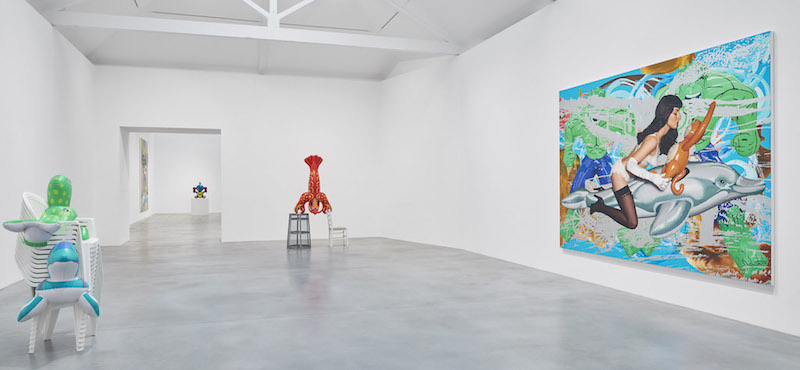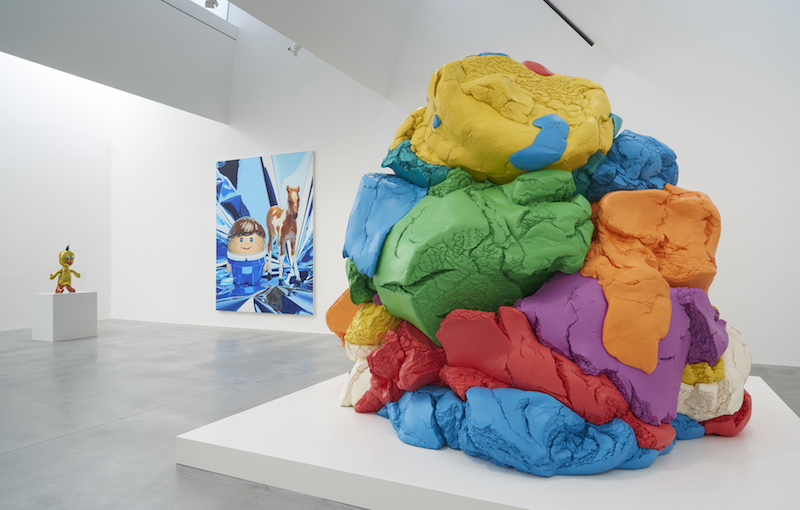The second exhibition staged by Damien Hirst in his stunning Newport Street Gallery is of work from his collection by the American artist, Jeff Koons. Hirst was still a student at Goldsmiths when, in 1987, Charles Saatchi showed Koons and other young Americans at his gallery in St John’s Wood. Hirst was blown away by the freshness and ambition of work that took Warhol’s love affair with consumer culture one stage further. This mini-retrospective can be seen, then, as a tribute both to Saatchi and Koons – inspirational figures in the 1980s.
A huge, sugar-pink bowl filled with perfectly white eggs occupies one’s field of vision in gallery three (main picture). Gazing up at this absurd object, you feel like Goldilocks encountering Daddy Bear’s enormous bowl of porridge – trapped inside a fairy tale featuring a bewildering amount to eat.
Koons's work is as nourishing as a diet of marshmallows Koons is preoccupied with fairy tales of another kind, though. The stories that interest him are written for adults rather than children, the ones that contribute to the myth of the American Dream and the accompanying belief that plenitude guarantees happiness. More is good, especially as more begets more; this is the mantra that fuels capitalism and, like the grossly oversized portions that many Americans stuff into their faces, Koons’s giant bowl of eggs is emblematic of excess production.
Don’t be seduced into thinking that he is critiqueing consumer culture, though. Bowl with Eggs,1994-2009 (main picture) makes you smile in much the same way that a boiled egg with soldiers make you feel good because of the nostalgia it induces. There’s no trace of irony; the sculpture doesn’t provoke you into contemplating the pros and cons of consumption, but sends you scampering back to childhood – wide-eyed and uncritical.
Koons’s work may be pleasing, but it is as nourishing as a diet of marshmallows. Based on adverts for cars and booze, images from the 1980s such as New Rooomy Toyota Family Camry, 1983 and Find a Quiet Table, 1986 encourage you to embrace the bland optimism fostered by ad campaigns and invest in their promises of pleasure. The feel-good factor is so strong that it’s like being bludgeoned with candy floss; you are left feeling nothing but numbness.
 Responding in Time Out to Koons’s exhibition at Anthony D'Offay’s gallery in 1994, I asked “Is Jeff Koons the worst artist in the world? Or the best? Or is he just inevitable?” Much of the work in this exhibition was on show then and I found its extreme lightness of being unbearable. I felt overwhelmed by the need to fill the void with meaning, so I discussed the work in terms of themes such as life and death, sex and gender, art and kitsch, desire and parody.
Responding in Time Out to Koons’s exhibition at Anthony D'Offay’s gallery in 1994, I asked “Is Jeff Koons the worst artist in the world? Or the best? Or is he just inevitable?” Much of the work in this exhibition was on show then and I found its extreme lightness of being unbearable. I felt overwhelmed by the need to fill the void with meaning, so I discussed the work in terms of themes such as life and death, sex and gender, art and kitsch, desire and parody.
And I am tempted to do the same again. I want to say that inflatable pool toys, like the lobster, seal and walrus which Koons casts in aluminium so that they remain pumped up hard, suggest anxiety about his virility (pictured above: installation shot with Seal Walrus (Chairs), 2003-9, Acrobat, 2003-9 and Girl with Dolphin and Monkey, 2009). So does Balloon Monkey, 2006-2013 with its permanently erect tail and face resembling a clitoris. The four-metre-high creature was made from balloons twisted into shape, enlarged, cast in polished stainless steel and then coated with a seductive blue sheen.
A photograph of the artist mounting his then wife, the porn-star La Cicciolina, was meant, he says, to free sex from any associations with fear, guilt and shame. “I went through moral conflict”, Koons wrote at the time, “in the preparation of my new work... I had to go to the depths of my sexuality, my own morality ... so when the viewer sees it they are in the realm of the Sacred Heart of Jesus.” Ice – Jeff on Top Pulling Out, 1991 gives off mixed messages; the artist is naked, but in a weird combination of innocence and knowing, Ilona wears a white corset, fishnet stockings, gold high heels, a garland of flowers and heavy make-up. In an accompanying shot, she licks a penis as semen drips from her mouth. The most uncanny thing about these highly staged scenes is that they appear so saccharine and joyless. I imagine a big box of Kleenex beside the bed to mop up leaking fluids.
 And yet I can’t help admiring Koon’s chutzpah. Some of the work is, perhaps unintentionally, funny; most is very clever. Building Blocks, 1996-2009 is a brightly coloured painting of a lego tower standing on a play mat in front of interlocking shapes. This gaudy evocation of kids' toys is also a complex exploration of spatial ambiguity that acknowledges hard-edged abstraction while cheekily mocking the seriousness of artists such as Kenneth Noland and Frank Stella.
And yet I can’t help admiring Koon’s chutzpah. Some of the work is, perhaps unintentionally, funny; most is very clever. Building Blocks, 1996-2009 is a brightly coloured painting of a lego tower standing on a play mat in front of interlocking shapes. This gaudy evocation of kids' toys is also a complex exploration of spatial ambiguity that acknowledges hard-edged abstraction while cheekily mocking the seriousness of artists such as Kenneth Noland and Frank Stella.
The most noticeable aspect of Koon’s work is the obsessive attention to detail. Every centimetre is perfectly rendered by machine to mimic human action, whether it be blowing up an inflatable, twisting a balloon or wielding a paint brush, thereby distancing it and rendering the act as clean, orderly and sterile as the sex.
My favourite piece is Play-Doh, 1994-2014, an aluminium cast of bits of Play-Doh piled into an unruly, multi-coloured heap (pictured above: installation shot with Play-Doh, Titi, 2004-9 and Boy with Pony, 1995-2008). The texture of the original is copied so exactly that each lump of metal looks as soft and squidgy as the real thing. The nearest that Koons gets to making a mess, the sculpture feels like a plea from a man trapped in clean-living bourgeois consumerism to be allowed to let go and experience the chaos and spontaneity of childhood.
Koon’s work may ostensibly be about the fulfillment of desire as promised by the American Dream, but to me it seems more like a cry for help from someone who desperately needs to allow some genuine filth into his over-managed life.
- Jeff Koons: Now at Newport Street Gallery until 16 October










![SEX MONEY RACE RELIGION [2016] by Gilbert and George. Installation shot of Gilbert & George 21ST CENTURY PICTURES Hayward Gallery](/sites/default/files/styles/thumbnail_125_x_125_/public/mastimages/Gilbert%20%26%20George_%2021ST%20CENTURY%20PICTURES.%20SEX%20MONEY%20RACE%20RELIGION%20%5B2016%5D.%20Photo_%20Mark%20Blower.%20Courtesy%20of%20the%20Gilbert%20%26%20George%20and%20the%20Hayward%20Gallery._0.jpg?itok=3oW-Y84i)




Add comment